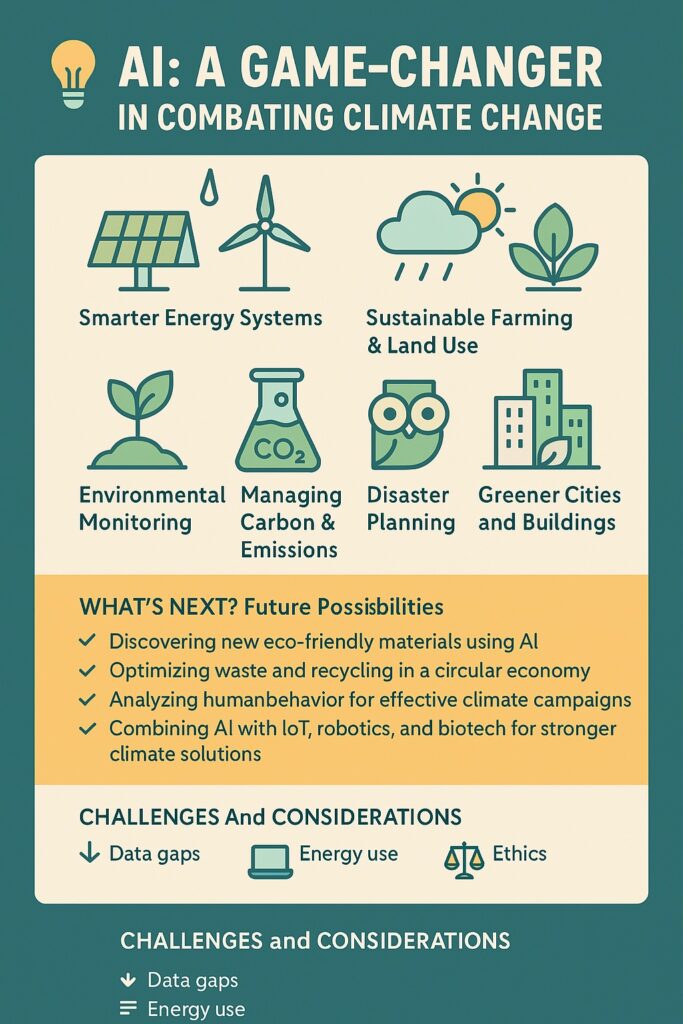🌍 AI: A Game-Changer in Combating Climate Change
Climate change is one of the biggest challenges facing our world today. To fight it, we need bold, scalable, and smart solutions. Artificial Intelligence (AI) is proving to be a powerful tool in this battle. With its ability to process big data, recognize patterns, and make accurate predictions, AI is helping us create a more sustainable future.
⚡ How AI Helps Fight Climate Change
🔋 1. Smarter Energy Systems
- Renewable Energy Boost: AI forecasts sunlight and wind to help optimize the use of solar panels and wind turbines.
- Smart Grids: AI balances energy supply and demand to reduce waste and integrate renewables.
- Preventive Maintenance: AI predicts equipment issues in wind and solar farms to avoid energy loss.
🌦️ 2. Better Climate Predictions
- Improved Forecasts: AI analyzes complex climate data for more accurate future climate modeling.
- Disaster Warnings: Early alert systems powered by AI help communities prepare for hurricanes, floods, and heatwaves.
🌾 3. Sustainable Farming & Land Use
- Precision Agriculture: AI helps farmers use water, fertilizer, and pesticides more efficiently.
- Deforestation Monitoring: Satellite images and AI detect illegal logging and forest loss quickly.
🦉 4. Environmental Monitoring
- Biodiversity Tracking: AI monitors wildlife with sensors, drones, and cameras to help protect endangered species.
- Pollution Detection: AI scans for air and water pollution, enabling quicker cleanup actions.
🧪 5. Managing Carbon & Emissions
- Carbon Capture: AI improves carbon capture technologies, making them cheaper and more effective.
- Emissions Tracking: AI ensures accurate reporting of emissions by industries and governments.
🚨 6. Disaster Planning
- Risk Assessment: AI forecasts where disasters like wildfires or floods might occur.
- Smart Relief: AI helps plan fast and efficient emergency response strategies.
🏙️ 7. Greener Cities and Buildings
- Energy-Saving Buildings: AI optimizes heating and cooling to save energy in buildings.
- Smart Urban Planning: AI uses traffic and energy data to help design eco-friendly cities.
🚗 8. Eco-Friendly Transportation
- Efficient Routes: AI finds the best routes to reduce fuel use in logistics and travel.
- Self-Driving Cars: AI-powered vehicles reduce congestion and cut down emissions.
🔮 What’s Next? Future Possibilities
- 🧬 Discovering new eco-friendly materials using AI
- 🔄 Optimizing waste and recycling in a circular economy
- 📊 Analyzing human behavior for effective climate campaigns
- 🔗 Combining AI with IoT, robotics, and biotech for stronger climate solutions
- 🏛️ Supporting governments with AI-powered decision-making tools
⚠️ Challenges and Considerations
- 📉 Data Gaps: AI needs lots of quality data, which isn’t always available.
- 💻 Energy Use: AI training can use a lot of energy — we need greener AI models.
- ⚖️ Fairness: Biased data can lead to unfair outcomes. Equity is key.
- 🔐 Ethics: We must consider privacy, safety, and accountability in AI systems.
- 🤝 Teamwork: Climate scientists, engineers, and policymakers must work together.
✅ Conclusion
AI has the potential to be a powerful force in the global fight against climate change. From making energy systems smarter to helping with disaster response and environmental conservation, its applications are growing fast. To fully benefit, we must use AI responsibly, encourage cross-sector collaboration, and keep ethics at the center. With the right approach, AI can help us build a cleaner, greener, and more sustainable world for future generations. 🌱
🚀 Final Thought:
Let’s embrace AI as a tool for good — when used wisely, it could be our strongest ally in saving the planet.
